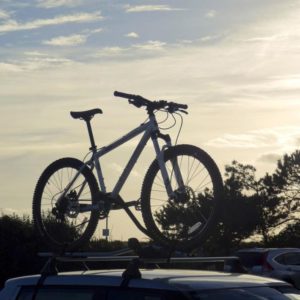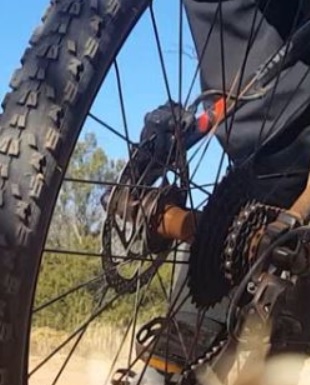My mountain bike brakes were acting up again the other day and it made realize how simple of a fix it can be when I finally learned about how to take care of rubbing disc brakes not too long ago. For a while, when I first got into the MTB scene, my brake pads rubbed against my rotors and it usually happened to me when I had to take off my quick release wheels and store my bike somewhere, or when I’m out on the trail and I’m really hammering down on the brakes. Something makes the brakes go out of wack.
Bike wheels and tires should always be spinning freely / effortlessly when you spin them! If not, there’s an issue.. and it’s usually from the brakes. It’s important to keep them up to shape and in working order.
When it began happening to me in the early days of my mountain biking adventures, I was just pushing off on the maintenance and not doing anything about it because I thought “it’ll fix itself.” Complacency is not the answer!
Well the disc rubbing does eventually fix itself, but it does so in a terrible way. The problem with mountain bike disc brakes that rub is:
- Premature wearing on your rotor and brake pad
- Annoying sounds and noises
- It’s actually slowing you down because the rub is ‘dragging’!
- Takes more energy away from you to pedal through it, sapping and robbing you unnecessarily
- You could potentially have brake caliper problems – rare, but a very serious danger
- It can potentially take away from maximum brake feel, modulation, and stopping power!
Fortunately it’s easily fixable and not a big deal most of the time, so don’t sweat it!
Contents
Easy Method To Adjust Your Disc Brakes From Rubbing That Works
Before we get into the fix, let’s first double check the MTB brake system (I’m speaking for hydraulic or mechanical disc brakes here).
- Make sure your brakes are free from all debris in and around the caliper, braker rotors, and brake pads
- Test your brake system by depressing the brake levers and watching for actuation from the brake pistons / brake pads gripping the rotor. If it’s not working, STOP, and give everything a second look
- Don’t ignore a problem, your brakes can save your life out there so get it fixed or take it into a local bike shop to get looked at
If everything above seems good, let’s get into how to fix the rubbing issue.
Centering and Aligning the Brake Caliper and Brake Pads: The Adjustment
- Get the bike into the air and onto a bike stand if you have one
- Loosen caliper mounting bolts for the suspect front or rear wheel (or both, but don’t take them completely off), usually with an allen key / hex wrench tool. This allows the caliper to move side to side.
- Depress the brake lever on suspect wheel
- Because you already had the caliper mounting bolts loosened, this now allows the freely loosened caliper to be CENTERED when the brakes are engaged
- While still depressing the lever, tighten the caliper mounting bolts (to the right torque specs if any). NOTE: This may require help from another person or using something to secure the brake lever being depressed in place
- Let go of brake lever, your brake caliper and pads should have the rotor center aligned and no more rubbing should be taking place.
- DONE.
- Take her for a test ride.
Advanced Troubleshooting: Rubbing Mountain Bike Disc Brakes
What if my brakes still rub?
Try above method again but use something very thin, like a piece of paper folded once (to double up thickness), in between the brake pad and the rotor on both sides. Repeat the alignment process above.
What if brakes are still intermittently rubbing when you spin it freely?
In this case, you may perhaps have a brake rotor that’s not true (bent) or a wheel that isn’t true. In the case of your rotors not being true, it’s usually best to just go buy a new brake rotor. Trying to bend them back may help temporarily but you’ll never get it perfectly straight, and oftentimes you’ll be using some kind of pliers or obscure tool like a flat head screwdriver to bend it back into place – it’s obviously not ideal!
Brake rotors are relatively inexpensive anyways and you can even find them on Amazon nowadays too if you don’t want to pay LBS prices.
It’s not very common for your wheels to cause brake problems (unless you use rim brakes – if you do, you probably don’t have a trailworthy mountain bike: see our affordable list of trailworthy bike recommendations here), but truing your wheels will take a little bit of know-how and having the proper tools to do so. It might be best to let the professionals handle truing of wheels, otherwise you can attempt it yourself by checking out this video:
Fine Tuning Brake Pads:
Sometimes your brake pads (on either side of the rotor) need a little more attention to get it dialed in. How do you do that?
In the case of Shimano brakes, you can “reset” the brake pads. To do this, you remove the wheel, remove brake pads, and using a tool to press the pistons all the way back (away from rotor). You may need to remove excess brake fluid for this. Then reinstall brake pads, place a “shim” or something that is the same thickness as the rotor between the pads, and depress the brake lever until braking performance is regained.
Bad Piston?
If you notice one of your brake pads still making contact with the rotor after all above steps, sometimes the problem is with the caliper piston itself sticking and not properly self adjusting. You can temporary fix this by using a common tool such as a flat head screwdriver to place between the brake pad and caliper, then twisting (like tighting a screw). This may fix the piston itself because it was stuck due to other reasons, but be cautious in it’s performance overtime. If this truly was the issue, you will need to get proper lubrication and a good cleaning of the piston done – or, it may just need to be replaced all together.
Bleeding your brakes:
I won’t go into the how-to of this, but If you have hydraulic brakes, sometimes you just need to get this done as it’s important to the overall performance of the brakes. Air may find it’s way into your brake system causing issues so if you haven’t done it in a while, you might as well get it done.
Get yourself some good brake rotor cleaner.
And just clean off your rotors. I ignored cleaning my rotors for the longest time because “oh well, they’ll get clean after I apply the brakes anyway,” but when you think about it, cleaning the rotors needs to be done pretty frequently for good reason:
- After washing the bike.
- You don’t want to let water or water spots dry on your rotor, sure you can just ignore it but that’s not best practice.. use brake cleaner
- After the bike is carried to a destination on a bike rack on your car
- Ever notice how much dust and dirt is collected on your car even if you just recently washed it? Well, when your bike is exposed to the same elements as your car down the road you can bet your brake rotors get the same coating of dust and dirt. CLEAN THEM before your rides.

Conclusion:
Keeping your brakes in check is pretty simple but it’s as important as brakes on a car. You need to be able to stop!
Disc rubbing is usually a simple fix with the alignment of your caliper, but many times you might have other issues with brakes that need attention. Don’t ignore your brakes!
Til next time,
See you out on the trail Rider Up!

